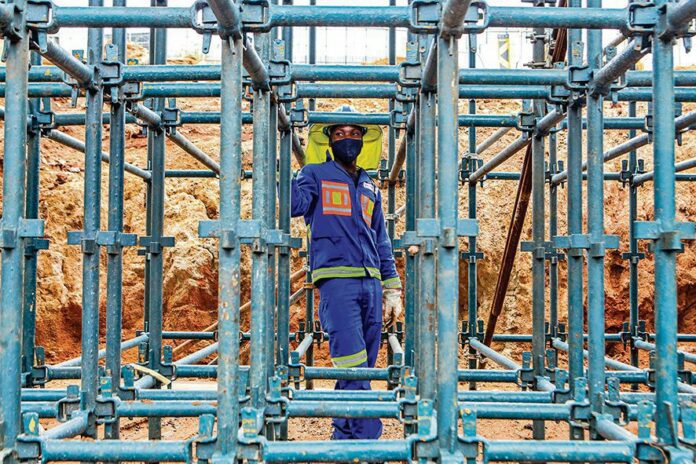Johannesburg – A government-commissioned report has painted a grim picture of occupational health and safety standards in South Africa.
The report, themed “A new beginning – launch of the South African state of OHS”, was on Friday launched by Employment and Labour Deputy Minister Boitumelo Moloi during a webinar. It was jointly commissioned by the International Labour Organization (ILO) and the Department in an effort to focus on the profile of OHS in workplaces.
Inspector-General Aggy Moiloa; National Institute for Occupational Health (NIOH) executive, Dr Spo Kgalamono; ILO Occupational Safety and Health (OSH) Specialist Peneyambeko Munkawa; Compensation Fund Commissioner Vuyo Mafata and Chief Inspector Tibor Szana also joined the webinar.
The report, which also provided a historical analysis of OHS in the country, contained several key themes and insights that came out of the confidential, semi-structured in-depth interviews with 34 purposefully selected participants.
It notes that while South Africa had century-long history of OHS legislation, which evolved from different pieces of legislation, the cabinet Memorandum of 1 of 1999, gave the then Department of Labour a mandate to lead a process of integration of all OHS legislation.
Moloi said this sets the stage for the development of the draft OHS policy in 2003.
She said: “Unfortunately, I must confess, that most of the commission’s and committee recommendations were not necessarily implemented. We didn’t reach what we were initially mandated to do.
“Consequently, South Africa remains with legislation on OHS under several different state departments.”
As a member of the ILO, she said South Africa has an obligation to develop a national OHS policy and strategy.
“It is against this background that the Department of Employment and Labour created an OHS profile for South Africa.
The ILO Convention 187 provides guidance on the establishment of the OHS.
“Among others, a literature review and primary data collection, analysis of quantitative.
“In the report, the ILO convention pointed out that South Africa’s legislation, although progressing, was “fragmented, complicated, and generally excludes the informal economy, and to certain extent, domestic workers.”
Moloi said fragmentation results in the inefficient use of limited resources.
“We are unable to reach our mandate, most of the time because of these deficiencies. Legislation is viewed as punitive and government’s role in OHS is compromised government departments were significant defaulters.
The report also found that government departments regulate OHS with little coordination and collaboration.
Level of awareness on reporting
The level of awareness on reporting was viewed to be poor among government employees.
“There is a general lack of reporting of work related injuries and diseases in the public sector. Work-related injuries and diseases data collection and reporting is fragmented and not harmonized among and within the different departments.
“There is no uniform way of recording and reporting injuries and diseases, and therefore there is no clear picture of the burden of the OHS injuries and diseases, especially diseases, which sometimes don’t get a recorded,” she said.
Further, the report said enforcement of legislation was a challenge, citing poor compliance by employers and serious limitations with human resource capacity.
Inspections and enforcement
Inspections and enforcement, the report found, was “generally reactive” in that inspectors tend to react to complaints and incident investigations.
“Suggestions by participants included that the processes of reviewing legislation should be fast tracked and that the South African Local Government Association should also provide basic facilities for informal economy workers to promote OHS,” it found.
Findings from quantitative data point to faults in inspections by the Department of Employment and Labour with little human resource.
The Deputy Minister said government was “trying to do more with the little that we have currently”.
In 2019, over 28 000 inspections were conducted with less than 300 inspectors at the time. The number of inspectors recently moved to 778 – 583 were currently in the field – after the employment of a further 500.
“So, the inspector to employee ratio will be one inspector to 17 600 employees. In terms of ILO standards, we are far from reaching compliant position that was supposed to be,” she said. Inspections show very poor compliance in the wholesale, retail, and iron and steel sectors.
Review legislation
While the country did not have a national OHS policy and strategy in place, a few Acts were currently under review. These included the COIDA amendment bill and OHS amendment bill.
“The ILO committee of experts on the application of conventions and recommendations, and stakeholders, have noted, the long time it takes to amend legislation in South Africa. We so we need to prioritize and fast track the process of reviewing this legislation.
“We will need to engage parliament to begin to shorten the period that we take to review legislation,” she said. – SAnews.gov.za
Also read:
Golden girl Schoenmaker takes gold in world record time
Follow @SundayWorldZA on Twitter and @sundayworldza on Instagram, or like our Facebook Page, Sunday World, by clicking here for the latest breaking news in South Africa. To Subscribe to Sunday World, click here.
Sunday World



